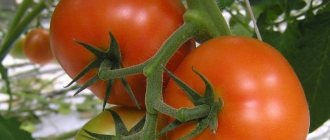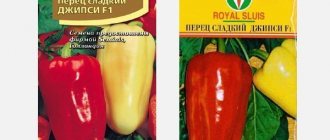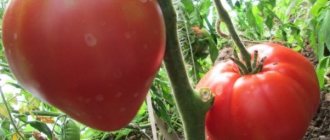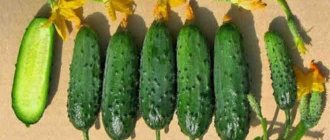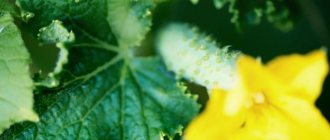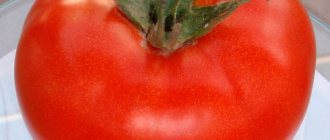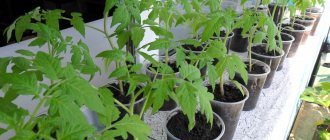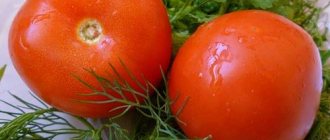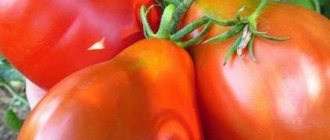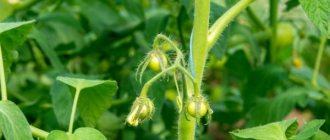Description of tomato Polbig
The tomato bush of the Polbig variety is quite strong and developed. The thickness of the stems can reach 12 mm. The roots of the plant are powerful and branched, penetrating to a depth of more than half a meter.
The height of a tomato bush depends on the method of growing the plant, as well as on the conditions under which it is kept. Thus, in the open air, bushes usually rarely have the opportunity to grow above 80 cm. In greenhouses, the norm is plants about one and a half times taller - from 1 m to 1.3 m in height.
Typically, the formation of a bush of this determinate variety is carried out in two or three stems, the clusters on which still need garter, due to the large number of very large fruits.
The leaves of this variety are medium in size and usually have a regular five-lobed shape. Their number is small. The drooping of stems and leaves is weak; hairs are practically invisible even on large stems. The color of the foliage is usually green, the stems are light green.
Flowers of this variety are common for tomatoes, except that they have a relatively short flowering time and go through this stage almost immediately after planting in open ground. Polbig has practically no barren flowers, so by the number of flowers you can already guess the yield of the bush, at least by the number of berries.
Ripening time ranges from 90 to 110 days (in greenhouses about 65-85 days) from the moment of appearance, depending on external conditions.
Below is a photo of a tomato bush Polbig f1
The ripening of fruits in this variety is quite early, which makes it the fastest in terms of yield among similar crops.
Important! The climate of Holland is much warmer, so seedlings can be planted in open ground at an earlier date. In the Russian climate zone, greenhouses must be used to produce Polbig tomatoes.
Description of fruits
Polbig tomatoes have the appearance shown in the photo
The fruits of the Polbig variety are slightly vertically flattened balls with a diameter of about 10 cm. Their weight can reach 220 g, although the range of average weights lies in the range of 180-200 g.
One of the features of the variety is that in greenhouses its ripening occurs faster by several weeks, while the mass of greenhouse fruits is approximately half as much as in comparison with “open” tomatoes (100-110 g).
The color of fruits in a state of technical ripeness is red. Their main feature is their extremely elastic skin and fairly dense flesh, which allows Polbig tomatoes to be stored for several weeks.
The pulp of the fruit is quite dense and slightly harsh, which, naturally, slightly improves its taste, but, along with long-term storage, allows tomatoes to be transported over long distances.
There are 3-4 large fruits on the clusters; in total, there can be up to a dozen clusters on the bush.
Advantages and disadvantages
According to reviews from vegetable growers, the Dutch hybrid Polbig has the following advantages:
- early ripening;
- high yield for its size;
- almost complete absence of barren flowers;
- smooth, beautiful fruits;
- good transportability and keeping quality.
But there are no ideal varieties. Disadvantages of the Polbig hybrid:
- sour taste of tomatoes;
- harsh skin on the fruit;
- the need for gartering and pinching of the bush.
Characteristics of Polbig tomato
The description of the characteristics of the Polbig f1 tomato suggests that it was created primarily for commercial use, as an early variety that appears on the market one of the first and can be grown far from its points of sale. It has a very high yield, early ripening (especially when grown in greenhouses), good shelf life and transportability.
Tomato yield Polbig
The variety has a very high yield. More than 4 kg of large-sized fruits can be harvested from one bush. But this is only possible if it is provided with the correct agricultural technology, one of the conditions of which is planting no more than 6 bushes per 1 square meter. m of garden area.
Despite the smaller size of the “greenhouse” versions of Polbig, due to its greater height, as well as the use of a three-stem bush formation scheme, it is possible to obtain the same yields in greenhouses as in open ground.
The fruiting period is also relatively short (compared to the ripening time) and is about 2 weeks. Usually, ripe tomatoes are removed from the bunch without waiting for all the tomatoes on it to ripen.
Area of application of fruits
The fruits of this variety are considered universal, however, it is recommended to use it fresh (juices, purees, sauces, etc.). If Polbig is used for conservation, it is advisable to use it entirely, without dividing it into parts or cutting it.
Resistance to diseases and pests
The plant is highly resistant to the following diseases:
- fusarium;
- verticillium;
- late blight
This tomato is susceptible to fungal diseases only when kept in a greenhouse under conditions of high humidity. As a preventive measure, greenhouses should be regularly ventilated.
Advantages and disadvantages of the variety
According to gardeners, the Polbig tomato has the following advantages:
- very early ripening time;
- flowering and formation of ovaries occurs at low temperatures;
- high resistance to diseases;
- good shelf life of tomatoes and their transportability;
- durable skin does not crack and preserves the presentation of the tomato;
- The size of 80% of tomatoes is approximately the same, which improves its commercial qualities.
However, along with a lot of advantages, the variety also has disadvantages:
- Tomatoes have a neutral taste;
- difficulty in forming a bush;
- the need to garter heavy brushes and stems.
Important! Based on the combination of advantages and disadvantages, the Polbig variety is more likely to be of interest to people involved in business, since it has all the useful qualities that a good and marketable product should have.
Polbig tomatoes on video
If you grew Polbig tomatoes, please write what the yield and taste of the fruit were in your climatic conditions? How do you rate the disease resistance of this hybrid? Briefly describe the advantages and disadvantages (pros and cons) of this tomato in your opinion. If possible, attach a photo of the entire bush or individual fruits you grew to your comment. Thank you!
Your reviews of the Polbig tomato and additions to the description will help many gardeners evaluate this hybrid more objectively and decide whether it is worth planting or not.
We remind you that to obtain the most delicious and aromatic fruits of any variety, tomatoes need loose, humus-rich soil, moderate watering, maximum sun and an optimal number of healthy leaves.
Features of planting and care
Growing a Polbig tomato is a normal tomato cultivation, the main detail of which will not be caring for the plant or feeding it (since they are, in fact, standard), but operations with seedlings.
Planting seedlings
Plants are planted in seedling boxes containing a special soil mixture. Usually its composition is garden soil and peat mixed in equal proportions. The seeds are buried to a depth of 1-1.5 cm. After which the seedlings are watered and covered with film.
Planting dates are determined based on which growing method will be used. It should be remembered that in the greenhouse it will be somewhat smaller, since technical ripeness will occur faster in fruits of smaller weight. In addition, the seedlings should be transplanted into open ground or a greenhouse approximately 2 months after they appear.
Important! Specific dates for planting seedlings are indicated within a fairly wide range (from 50 to 70 days), so you should always remember that the total period for the onset of ripeness for a variety is about 100 days.
So, if you plan to produce tomatoes in a greenhouse by the beginning of May, the seedlings must be planted in early February and transplanted in early April. In cold climates this cannot be done; therefore, it is necessary to use a greenhouse or hotbed.
If it is necessary to obtain a harvest in mid-June, seedlings are planted in mid-March, and planted in the second ten days of May. Such terms make it possible to grow the Polbig tomato variety in open ground.
Caring for tomato seedlings is standard and includes regular watering, providing them with sufficient light, and hardening off before planting.
Planting in open ground and subsequent care
Typically, seedlings are transplanted into a greenhouse or beds on the 65th day after planting. In both cases, a standard planting pattern of 50 x 40 cm is used. In this case, it is necessary that per 1 sq. m accounted for no more than 6 tomato bushes.
Watering, fertilizing, loosening the soil and removing weeds should be regular.
Bush formation
According to reviews of the Polbig tomato, most of those who have grown it strongly recommend using the formation of a bush with three stems in a greenhouse. This uses the main stem and the first two (lowest) branches. The remaining branches are removed.
Diseases and pests
The variety has good resistance to diseases such as verticillium and fusarium.
Read more about diseases of tomatoes in greenhouses in the articles on our website, as well as about methods and measures to combat them. You will also be able to get acquainted with information about high-yielding and disease-resistant varieties, about tomatoes that are not at all susceptible to late blight.
Our website contains a lot of useful material about nightshade diseases:
- Alternaria blight.
- Late blight and measures to protect against it.
- Fusarium.
- Verticillium.
And about pests that can damage your plantings:
- Colorado beetle.
- Slugs.
- Medvedki.
- Aphids.
- Spider mites.
Positive and negative qualities of a hybrid
Summarizing all of the above, we can highlight the following advantages of the Polbig tomato:
- early ripening of fruits;
- uniformity of size and color, which gives an aesthetic presentation to the product;
- resistance to cracking, and, therefore, good transportability;
- is well preserved without losing its presentation;
- fruit resistance to diseases.
Despite a number of positive qualities, there are also some disadvantages:
- the taste is not at the highest level - the pulp is too dense, without a pronounced aroma, there is no sweet taste and sugar content;
- the need to form a bush using pinching;
- the need to tie up the stem and side vines so that the bush does not break under the weight of the harvest.
Reviews from gardeners
Maria, 29 years old, Krasnodar
I spent a long time choosing a variety of tomatoes to grow in a greenhouse in the fall and winter. As a result, according to the characteristics, reviews, and photos of the bush, the Polbig F1 tomato was the best fit. The plant is medium-sized, no more than 70 cm high. About 8 fruits are formed on each. Seed germination was almost one hundred percent. The fruits are distinguished by their regular shape and bright red color. Polbig turned out to be resistant to temperature changes. During the day, the temperature in the greenhouse remained at +25 degrees, and at night dropped to +10 degrees. A total of 50 bushes were planted, from which 60 kg of tomatoes were harvested.
Victor, 47 years old, Ufa
Polbig is one of the earliest varieties of tomatoes ripening on my site. Tomatoes have good taste and high yield. The variety is suitable for retail sale and is also unpretentious in cultivation. The plant is low-growing, which greatly simplifies its care.
Svetlana, 27 years old, Zelenograd
Polbig was grown to produce tomatoes for salads. I chose it largely based on reviews of the Polbig F1 tomato. The seeds have good germination, but otherwise I didn’t see anything remarkable about it. The variety can be used to obtain a stable yield of medium-sized fruits (weighing about 200 g). The fruits are smooth and do not crack when ripe. Polbig does not require special care, which significantly saves time on caring for it.
Transfer
The readiness of seedlings and weather conditions are the two main factors that gardeners rely on before transplanting Polbig F1 tomatoes.
A strong stem and 6–7 leaves and an air temperature of at least +13 °C indicate that it is time to plant the seedlings in a permanent place. It is also equally important that the height of the sprouts reaches 15–17 cm.
To the greenhouse
Before replanting, the soil should be fertilized. To do this, you can use any organic fertilizer (yeast, ash, iodine, boric acid). Tomato sprouts are carefully removed from the pots, taking care not to damage the root. Make holes 19–20 cm deep and plant Polbig f1 together with the soil from the container, maintaining a distance of 40 cm between the bushes.
In open ground
Dig small holes (20 cm) and plant seedlings in them along with soil from cups. A distance of 35–45 cm is maintained between tomato bushes in the beds, and a little more between the rows. Only such parameters will allow the root system to form correctly.
Expert opinion
Stanislav Pavlovich
Gardener with 17 years of experience and our expert
Ask a Question
Important! To ensure that the seedlings take root well, you can add Kemir or Mortar to the soil. These are special stimulants that will help the further growth of tomatoes.
Before planting Polbig seedlings and after work, water the soil with warm, settled water.
Similar hybrids
The Polbig tomato hybrid can be compared in description and characteristics with the following varieties of tomatoes:
- Tomato Polfast. A determinate hybrid with a height of 50-60 cm. Early (85-95 days) and rapid ripening of the crop allows you to grow tomatoes in open ground even in the Moscow region. Tomatoes are round in shape, sometimes with slight ribbing, and red. Weight ranges from 100 to 150 g. The fruit pulp is sweet and dense. Polfast is suitable for fresh use and for preparations. Productivity - from 3 to 6 kg of tomatoes per bush. The species is resistant to the main diseases of nightshades and sets fruit well at low air temperatures.
- Sultan. Hybrid plant of early ripening. The first ripe tomatoes are harvested 90 days from the sowing date. The bush is short - 60 cm, but the stem requires garter due to the heaviness of ripening tomatoes. The fruits are spherical, red, weighing up to 200 g. They tolerate transportation and storage well for 3-4 weeks. The hybrid is resistant to fusarium and verticillium. If overwatered, the skins on the fruits may burst. Sultan is recommended to be planted in open ground and greenhouses. Productivity up to 5 kg per 1 sq. m.
- Tomato Blagovest. A hybrid reaching a height of 140 cm. Requires garter, often the plant is formed into 2 stems. The tomatoes are red, round, weighing 100-120 g. The harvest ripens 3-3.5 months after the sprouts appear. The taste is sweet and sour, rich. The purpose of tomatoes is universal. Each plant ripens up to 4 kg of fruit. The hybrid is immune to fusarium, cladosporiosis, and tobacco mosaic virus.
- Verlioka. A productive and early ripening hybrid. It is characterized by cluster fruiting, with up to 10 fruits ripening in each cluster. The height of the plant is 120-130 cm, formed into one stem. Tomatoes are grown in open ground and greenhouses. It is resistant to the main diseases of the nightshade family. Tomatoes on bushes ripen 100-120 days after sowing. They are round, smooth, with smooth, durable skin. Fruit weight is 90-100 g. The pulp is juicy, sweetish, with a pronounced aroma. The purpose of tomatoes is universal. The yield is 4 kg per plant.
- Katya F. Early ripening tomato, the harvest is ready for use 80 days after the sprouts appear. The type of bush is determinant (height 60-100 cm), formed into 2-3 trunks. The tomato cluster is laid after the 6th leaf, in a bunch of up to 7 fruits. Katya tomatoes are smooth, round, with thin but strong skin. Fruit weight 120 g. The taste is sweet and sour, pleasant, the pulp is juicy. Suitable for fresh consumption and all types of canning. From one plant you get from 3 to 5 kg of harvest. The tomato is resistant to stress, cracking, blossom end rot, and is not affected by late blight.
How to grow tomato seedlings yourself
Having decided to plant an expensive hybrid from the Netherlands on your plot, you need to come to terms with the fact that the seedlings of such a tomato will need to be grown yourself. Since it is impossible to determine the varietal identity of a plant by the appearance of a young bush, seedlings of valuable hybrids are rarely grown for sale, and having found a similar product on the market, you can never be sure that the plant corresponds to the declared characteristics.
Optimal timing for sowing
You should never rush to sow tomato seedlings.
Chicken diseases: main types, the most dangerous diseases, signs and tips on how to cure at home (95 photos + video)
The soil
When choosing soil for seedlings, you can act in two ways, each of which has its own advantages and disadvantages:
- buy ready-made substrate for seedlings;
- Prepare your own soil mixture.
Video: Soil for seedlings
However, gardeners note that seedlings in open ground take root much better if the seeds are sown in soil similar to that where the adult plant will be located. From this point of view, it is better to prepare the soil mixture yourself. For the hybrid Polbig f1, a suitable substrate is made up of a mixture of equal parts of only two components - garden soil and peat.
- Freezing. It is carried out in several stages. First, the container with soil is taken out into severe frost (at least -10 °C) for 10–12 hours, then returned to a warm room and left for another similar time. It is necessary that all pests in the soil, once in the warmth after frost, “perceive” such a change as the arrival of spring and come out of hibernation. Then the substrate is again taken out into the cold, where it is kept for at least a day. During this time, the majority of harmful microflora should die. To be on the safe side, you can repeat the procedure several times.
- Calcination. The substrate for seedlings is poured onto a baking sheet and placed in an oven preheated to +70 °C for several hours. It is not recommended to use a higher temperature, since too hot air can destroy not only harmful, but also beneficial microorganisms.
- Treatment with a disinfectant solution. A weak solution of potassium permanganate is usually used as such an antiseptic. The soil mixture is watered generously, after which you just need to let the liquid evaporate.
Growing container
There are several types of containers for growing seedlings. For these purposes the following can be used:
- shallow boxes, boxes or other similar containers;
- disposable cups;
- special cassettes for seedlings;
- peat tablets.
Seed preparation
Agricultural technology for growing seedlings of most varietal tomatoes and many hybrids involves carrying out serious preparatory work with seeds - sorting, soaking in growth stimulants, dressing, hardening. Polbig f1 does not need such procedures.
Sowing seeds
The scheme for planting tomato seeds in seedlings is always standard. The depth of the bookmark is 1 cm, the distance between individual copies (if flat boxes or boxes are used, and not individual cassettes) is approximately 3 cm.
It is better to organize the sowing procedure as follows:
- Pour soil into the prepared containers in a volume 10 mm less than planned.
- It is very good to water the soil with slightly warmed water and allow excess moisture to escape through the drainage holes.
- Carefully, for example, using the tip of a knife, place the seeds in a given pattern directly onto the surface of the soil.
- Sprinkle the container with a centimeter layer of substrate.
- Using a spray bottle, carefully spray the surface of the soil, but under no circumstances water it, so as not to bury the seeds.
Video: Sowing seeds for seedlings
Seedling care
Containers with seedlings should be covered with film or covered with glass to create a greenhouse effect and placed in a warm (+25...+27 °C) and very bright place. Periodically, the film should be removed to ventilate the soil, and the top layer of the substrate should be carefully sprayed with a spray bottle.
After the first shoots appear (approximately on the fifth or sixth day after planting), the film is gradually removed. First, the shelter should be removed for several hours during the day and returned to its place at night, then increase this time and only then remove it completely.
Sprouted seedlings are transferred to a cooler (+20...+22 °C), but still well-lit place for growing.
- before the bushes get stronger, watering should be done by drip, for example, using a pipette or a disposable syringe without a needle;
- Excessive watering for young plants is as unacceptable as drying out the soil.
About a week after picking, you can begin to feed the seedlings in such a way that before planting them in open ground, fertilizer is applied three times at equal intervals. To enrich the plant with nutrients, you can use any mineral fertilizers for tomatoes, for example, Agricola, Effecton-O or regular nitrophoska, alternating them with each other.
Hardening of seedlings
Planting tomatoes in open ground always means that the plant moves from a warm room protected from wind, direct sunlight and other unfavorable factors to much more harsh conditions. At the same time, the bush is removed from the container where it grows, which cannot be done without disturbing the root system. Such double stress may be too much for a young tomato, and in order to slightly weaken its negative reaction, the pre-hardening method is used.
Hardening of tomatoes should begin approximately two weeks before the expected date of planting seedlings in open ground. During this time, containers with young plants are taken out into the open air (for example, onto a balcony or loggia), first for a couple of hours in the warmest and not very sunny time. Then the period of the seedlings being outdoors gradually increases, and the conditions offered to the plants become more stringent (after all, tomatoes must have the “experience” of being in an open space for a full day - cold night and day, under the baking rays of the sun).
